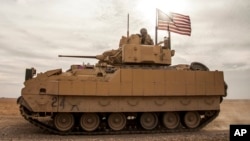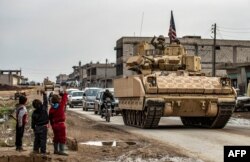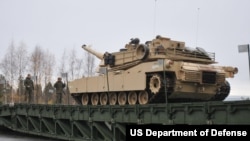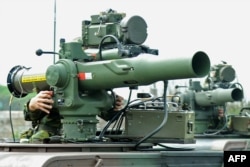The Biden administration this week announced that the U.S. would provide advanced Bradley Fighting Vehicles to Ukraine for use in its fight against Russia’s invasion, a move that experts said would make a significant though not decisive difference in the conflict.
The Bradley is a powerful weapon platform that has the ability to destroy enemy tanks. It can also be used to scout the battlefield and to rapidly move small numbers of infantry in relative safety.
The Bradleys are being sent as part of a larger $2.85 billion aid package. The announcement came on the same day that German Chancellor Olaf Scholz said his country would provide Marder combat vehicles, similar to Bradleys, and a Patriot air defense system to Ukraine. The previous day, France announced that it would be providing AMX-10 RC armored fighting vehicles.
The moves mark an escalation of the support for Ukraine by the U.S. and its allies, which had hesitated to send systems like the Bradley for fear of provoking Russian escalation.
On Thursday, Ukrainian President Volodymyr Zelenskyy said, “Today I would like to personally thank President Biden and Chancellor Scholz for the decision to strengthen our defense, a very important decision.” He described the weapons transfer as “a great victory for our state.”
Significant shift
Retired U.S. Army Colonel Liam Collins, the founding director of the U.S. Military Academy’s Modern War Institute, told VOA that while it wouldn't by itself tip the balance of the war in Ukraine’s favor, the Bradley could help Ukraine significantly.
"It's a big deal — it's still arguably the best infantry fighting vehicle in the world — but no single weapon system is going to win or lose the war for Ukraine,” said Collins, who also served as a U.S. adviser to Ukraine from 2016 to 2018.
He said that the decision to provide the Bradley to Ukraine was part of a significant evolution in the way the U.S. and its allies appear to be thinking about the conflict in Ukraine and the capability of the Ukrainian military.
“Before the war started, no one in the U.S. gave Ukraine a chance, and so the aid that was given to them was just really small things that could get there quickly,” he said. Javelin anti-tank weapons and Stinger surface-to-air missiles, he said, were “just things to inflict harm on Russia, but not anything that was going to actually win the war.”
That initial aid was eventually supplemented by longer-range artillery, drones and other equipment that has allowed Ukraine to dislodge Russian troops from much of the land that was occupied at the start of the war.
He added, “As we've seen this go on, there's been more and more of a commitment to providing aid that can actually help them win. And, as we've seen throughout the war, Ukraine is the better military. Russia's single and only advantage is the size of its military.”
Tank compromise
Zelenskyy has for months been urging the U.S. and its allies to send tanks to Ukraine, but has been met with reluctance. One reason for that reluctance has been the difficulty of maintaining extremely complex systems like the U.S. M1 Abrams main battle tank in the field. Doing so requires highly trained specialists and reliable logistical support.
Additionally, with a 1,500-horsepower engine — approaching three times the size of a Bradley’s — an Abrams tank burns through fuel at a very high rate, further complicating logistics.
Michael Akopian, a researcher in the Defense Program at the Center for a New American Security, a Washington think tank, told VOA that the Bradley offers many tank-like capabilities but is much simpler to operate and maintain.
“A Bradley could be better than a tank, in a way, because of the maintenance,” Akopian said. “We're dealing with diesel motors on these instead of the really complicated, turbine-like engines that the Abrams tank has. It’s easier to maintain and it's easier to keep it clean.
“The last thing that you want is to have a brand-new Abrams tank that gets stuck somewhere and you can't move it because you don't have the logistics infrastructure in place right now.”
The Bradley, according to Akopian, “is a good compromise between everything that they need while also being realistic about the challenges that the Ukrainian military does face.”
Bradley details
The Bradley Fighting Vehicle has been in service since the 1980s, though upgrades applied through the years have kept it advanced enough to be one of the most effective vehicles of its type in the world.
The Bradley comes in different variants tailored to different uses. In general, though, the vehicle weighs approximately 28 tons, runs on treads like a tank, is well-armored, and carries three major weapons systems that make it a powerful foe on the battlefield. One configuration, with a crew of three, can carry an additional six infantry soldiers.
The Bradley’s main weapon is a 25 mm M242 Bushmaster chain gun, also referred to as an “autocannon” that comes equipped with both armor-piercing and high-explosive incendiary ammunition. Mounted beside that is a 7.62 mm machine gun. In addition, the Bradley carries tube-launched, optically tracked, wire-guided (TOW) missiles, which are capable of disabling larger tanks.
The Bradley’s main gun and the TOW missiles both have an effective range of more than 3,000 meters, which is greater than the effective range of many Russian tanks. This means that the smaller Bradley can attack a tank while remaining out of range itself.
The Bradley first saw significant service in the 1990-91 Gulf War, where it earned a reputation as an effective “tank-killer,” destroying more Iraqi tanks during the conflict than the United States’ larger and more powerful M1 Abrams did.
Since then, the Bradley has played a major role in multiple military actions, including in the wars in Afghanistan and Iraq.














